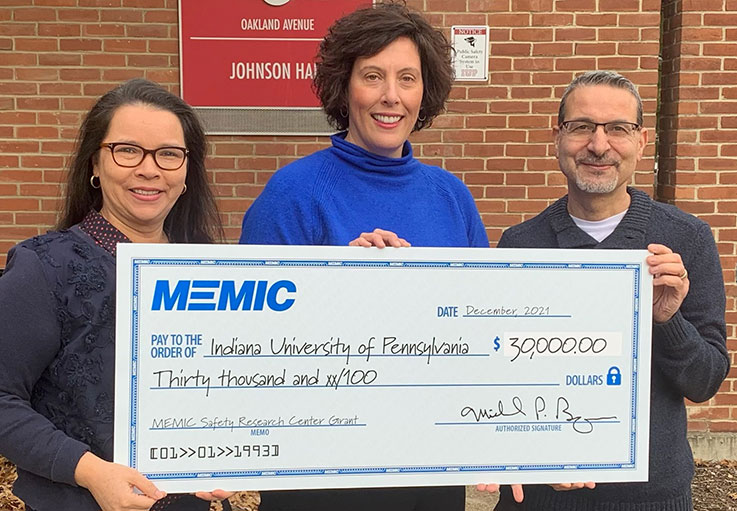The MEMIC Group, specialists in workers’ compensation insurance, has awarded $30,000 to a faculty research team in IUP’s Department of Safety Sciences to investigate ways to limit workplace slips, trips, and falls.
 Wanda Minnick will lead the research, along with two co-investigators: Luz Stella Marin and Majed Zreiqat. IUP graduate student Cory Gaye and an undergraduate student also will be part of the research team.
Wanda Minnick will lead the research, along with two co-investigators: Luz Stella Marin and Majed Zreiqat. IUP graduate student Cory Gaye and an undergraduate student also will be part of the research team.
The grant is the first administered by the MEMIC Safety Research Center, founded in February 2021 to advance the science of safety by leveraging academic research to effectively address new risks employees and employers face in the modern workplace.
In its proposal, IUP researchers noted injuries caused by slips, trips, and falls were the second most common cause of workplace injury in 2020, accounting for 18.2 percent of all workplace injuries and illnesses with an estimated direct cost of nearly $11 billion. The incidents are more prevalent in construction industries, which in 2019 had a higher total average rate of slip, trip, and fall injuries than the average in all industries based on US Bureau of Labor Statistics data.
“Our mission is ‘making workers’ comp work better,’ so that means conducting research to understand and reduce the probability and frequency of occupational injuries and illnesses, including injuries from slips, trips, and falls that are preventable yet still stubbornly prevalent,” said Luis F. Pieretti, manager of industrial hygiene at the MEMIC Group and architect of the MEMIC Safety Research Center. “We are confident our first-ever MEMIC Safety Research Center grant will allow researchers at Indiana University of Pennsylvania to follow through on a number of interesting research questions that will help create actionable solutions to these preventable injuries.”
 The study will examine how construction workers adjust the biomechanics of walking to compensate for fall risks on variable site surfaces. Specifically:
The study will examine how construction workers adjust the biomechanics of walking to compensate for fall risks on variable site surfaces. Specifically:
- Whether walking parameters such as stability, stride regularity, and speed change on common walking surfaces in a construction site.
- What the perceived risk factors are for slips, trips and falls on common walking surfaces.
- How a type of walking surface may influence construction workers’ stability.
- How construction surfaces influence loss of balance.
- How wearable devices might enable anticipation of such hazards.
“We hypothesize construction workers constantly adjust the biomechanics of walking to compensate for the falling risks associated with various walking surfaces in a construction site,” the researchers wrote. “Thus, getting timely information of the balance disruption level will inform the implementation of temporary controls (e.g., walking speed reductions, traction mats, handrails, guidelines) to minimize the likelihood of STF-related injuries.”
Minnick and her team will simulate construction surfaces in the IUP Department of Safety Sciences Laboratory and will assess biomechanics parameters (e.g., speed, stability, motion, joint angles) using wearable devices and motion tracking system technology.
“We are very excited to work with the MEMIC Group and honored to have been selected for this grant,” Minnick said. “It’s a great opportunity to add to our department’s ongoing work in creating safe workplace environments while involving our students in hands-on research, and we are very grateful to the MEMIC Group for their commitment to this critical issue.”
MEMIC Safety Research Center issued a nationwide call to higher education institutions in 2021 for grant applications to seek, understand, and reduce the probability of occupational injuries and illnesses. The MEMIC Safety Research Center will repeat this call annually.
“We often use safety techniques designed in the twentieth century to address risks created in the twenty-first century. Some work; some do not. This is where research comes in,” MEMIC Senior Vice President of Loss Control and Safety Services Karl Siegfried said. “We are pleased to be collaborating with IUP researchers to study slips and falls that create workplace injury, and we look forward to many more such collaborations with academia to make workplaces safer.”
Visit MEMIC for more information about the MEMIC Safety Research Center and to view requirements for future grant proposals.
PHOTO INFORMATION: Group photo: from left, IUP Research Team members Luz Stella Marin, Wanda Minnick, and Majed Zreiqat.
Individual photo: Team member Cory Gaye, IUP Safety Sciences graduate student
###
About MEMIC
The MEMIC Group includes MEMIC Indemnity Company, MEMIC Casualty Company, and parent company Maine Employers’ Mutual Insurance Company; all rated “A” (Excellent) by A.M. Best. The MEMIC Group holds licenses to write workers’ compensation across the entire country. The group insures and serves more than 20,000 employers and their estimated 300,000 employees with dedicated safety and injury management service teams from Maine to Florida.
About IUP Safety Sciences
IUP's program in Safety, Health, and Environmental Applied Sciences is the program of choice for industry partnerships in the global safety, health, and environmental professions. It is consistently recognized as one of the top programs in the nation, most recently ranked as third in the nation by Universities.com. The Department of Safety Sciences has grown to be the only institution in Pennsylvania to offer three degree programs in safety sciences; an ABET-accredited BS in Safety, Health, and Environmental Applied Sciences; an MS in Safety Sciences that is a qualified academic program per the Board of Certified Safety Professionals; and the nation's only hybrid PhD in Safety Sciences (primarily distance learning classes supplemented by summer workshops). The program prepares students for work in a wide range of areas, including manufacturing, oil and gas, insurance, healthcare, construction, distribution, government, transportation, and the service industry. The Department is home to the Pennsylvania Occupational Safety and Health Administration (PA/OSHA) Consultation Program, which provides a variety of trainings and informational offerings, as well as on-site evaluations.
The Department of Safety Sciences at IUP was formed in 1969 through a National Institute for Occupational Safety and Health grant. The purpose of the grant was to establish a baccalaureate program in safety management for academic preparation of students to become safety professionals in industry, government, and institutional settings. IUP's program is believed to be one of the first safety programs in the nation and one of the only programs offering degrees through the doctoral level.